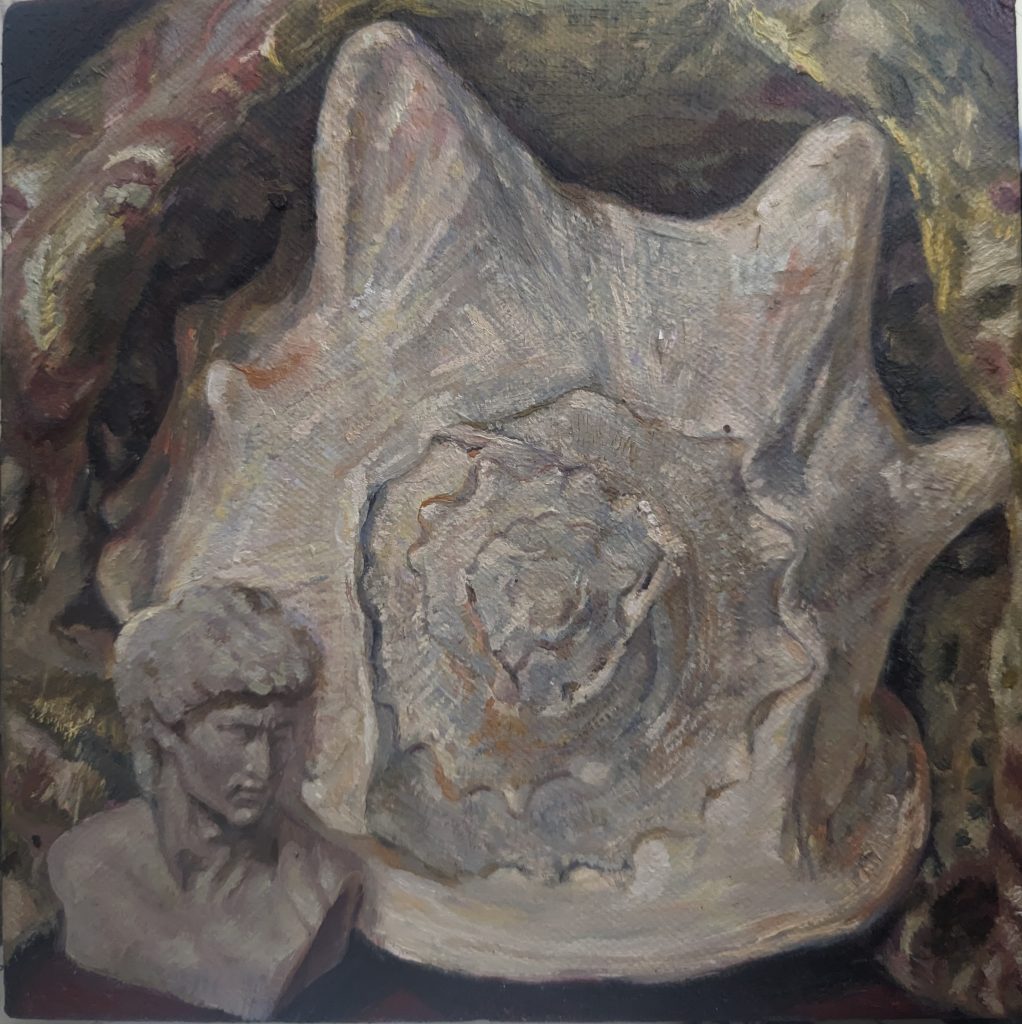
Combining love, nature, antiquity and rich tapestries in this recent oil painting, created on a 20cm x 20cm deep edge canvas.
Keep an eye out for the final artwork..

Combining love, nature, antiquity and rich tapestries in this recent oil painting, created on a 20cm x 20cm deep edge canvas.
Keep an eye out for the final artwork..

A throwback to one of my oil painting studies in 2005, part of my art project which explored cultural identity and the intellectual legacy of indigenous cultures, as well as ‘non-western’ cultural traditions.
Painted on A3 cartridge paper (in very small brushes!), it depicts ‘Eun Ju’, after artist Andrew Tift’s ‘Alexander and Eun Ju.’
The original portrait took on new significance for me as it was Tift’s subjective take on Jan Van Eyck’s Arnolfini marriage, painted in 1422-4. Filled with symbolism, it shows both the unifying, protection and preservation of cultures, something of interest to me with my own cultural background.
Eun Ju wears a hanbok, perhaps to sustain Korean tradition. Along with language, religion and cultural patterns such as dance, food, housing and aesthetics, apparel plays a vital role in the preservation and expression of cultural identity.
My school entered my art project, titled ‘Vanishing Cultures’ into the Surrey Art Award, and I’m delighted to say it won first place.
I had begun selling my paintings to my teachers a few years before this, but around this time I began portrait commissions that continued to this day.
I have always had a love for the whimsical nature of nutcrackers, these wooden toy soldiers from late 17th-century Germany with their bright colours. According to German tradition, they are symbols of good luck and will frighten away malevolent spirits. They originate in Erzgebirge, or the Ore Mountains, a forested region known for handmade wooden products, arts and craftsmanship. They were given as gifts and soon became associated with Christmas.
This is a glimpse of my work in progress artwork, painted in oil on linen as a Christmas gift.
Keep an eye out for the final painting!
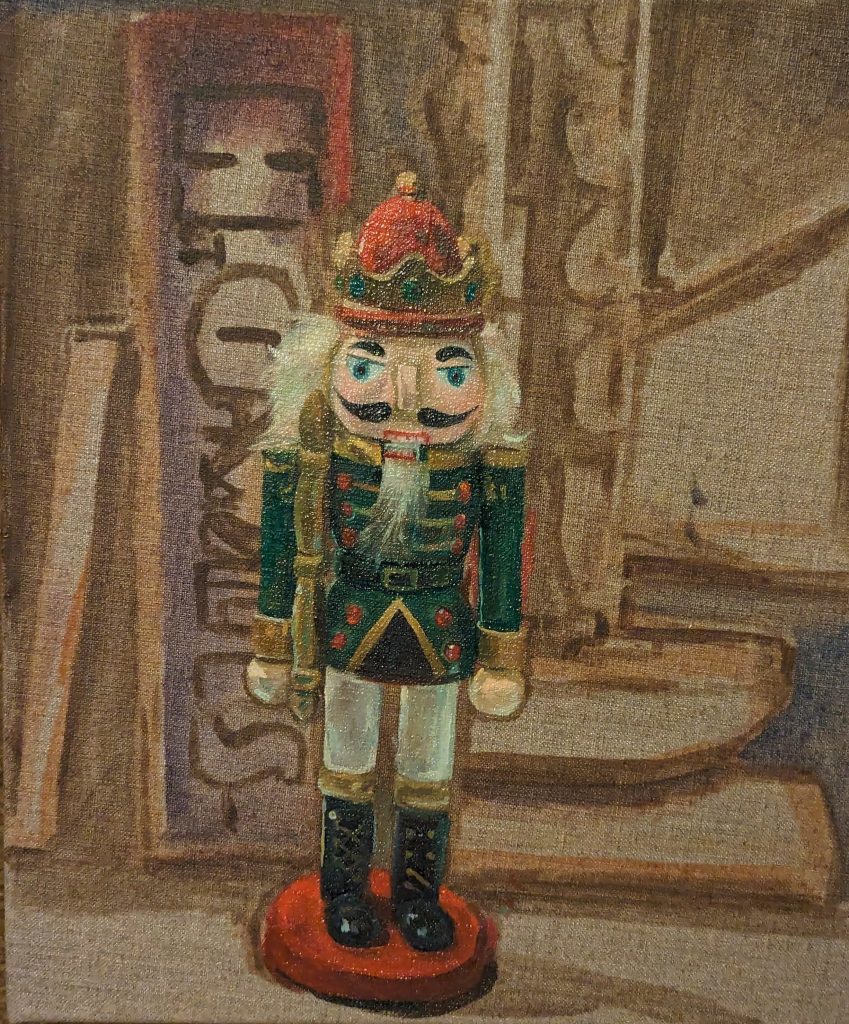

I’m delighted to be exhibiting a new series of original oil paintings at the best-known regatta in the world, Henley Royal Regatta (also referred to as H.R.R.) in July.
This quintessentially British event is a highlight of both the summer sporting calendar and the social season, attracting thousands of spectators to watch over 300 races of an international standard. These races include Olympic rowers as well as new crews.
The Stewards’ Enclosure is situated on the Berkshire side of the river and is open to Members and their Guests. Perfectly positioned with a view of the Finish Line, the Stewards’ Enclosure boasts two Grandstands from where you can watch the racing and enjoy sweeping views of the Regatta Course, with the stunning backdrop of Henley town and St Mary’s Church tower.
My art will be on display at the Art Gallery within the Stewards Enclosure, with a preview evening on one of the event days.
Rules of the Regatta dictate that artworks should encompass one or more of the following three themes:
Whether you’re a first-timer or a seasoned Member, the Regatta is sure to offer you a great day out – with plenty of racing action, great food & drink, and an electric atmosphere.
More details coming soon!

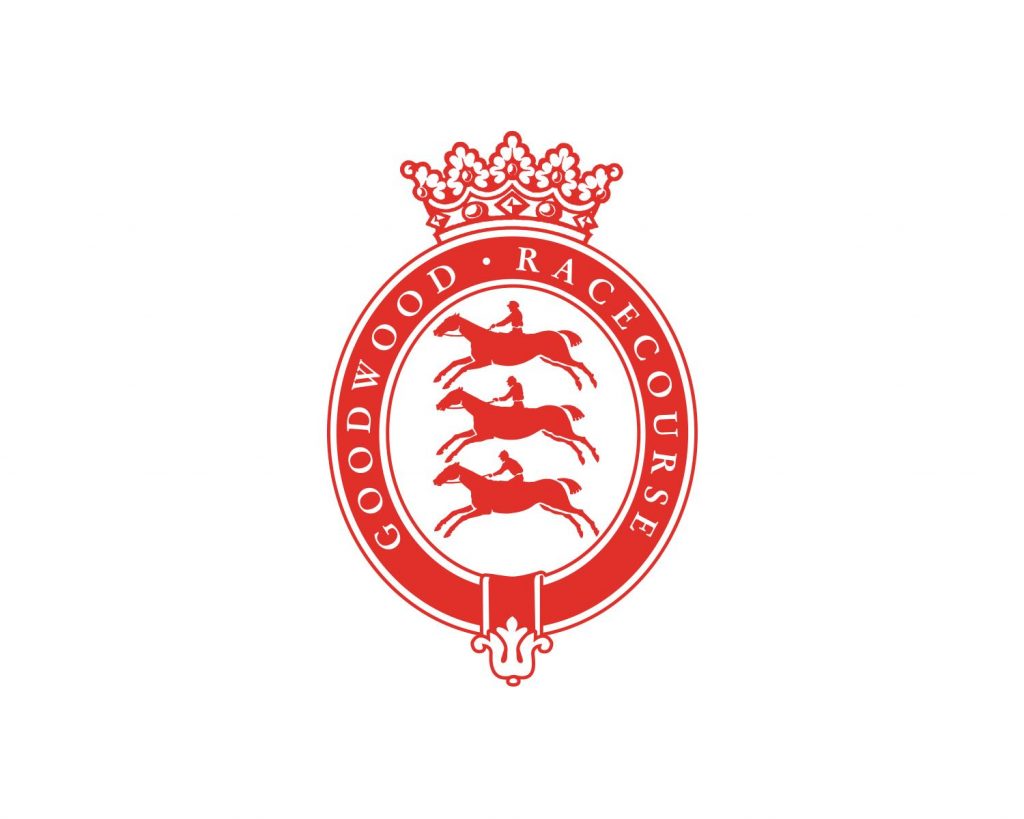
I’m excited to exhibit at Sussex Art Fair, within the beautiful surroundings of the Goodwood estate at Goodwood Racecourse in May.
Sussex Art Fair takes place at Goodwood Racecourse, Selhurst Park Road, Chichester, West Sussex PO18 0PS, in the heart of the Sussex Downs where you can experience 90 exhibitors with 1000s of artworks available for purchase.
Starting on the Friday Preview Evening, visitors will be able to browse their favourite artworks along with a complimentary glass of bubbly and be the first to view exhibitors collections before the event opens to the general public over the weekend.
Facilities include extensive visitors parking, wheelchair accessibility, a full café serving tea, coffee and food.
Sussex Art Fair continues its collaboration with Sussex Wildlife Trust, a conservation charity that cares about protecting the wonderfully rich natural life that is found in our Sussex towns, countryside and coast. Visitors can purchase original artworks kindly donated by our exhibitors, each work priced at £50 with all proceeds going to the charity.
Being the largest art fair within the Sussex Counties, Sussex Art Fair is the perfect place to begin your art collection, or indeed add to your collection if you are already a seasoned art enthusiast.

Aside from painting a nutcracker over Christmas, I also painted a delightful tractor ornament as a Christmas gift. The Model D was introduced in 1923 as John Deere’s first mass-produced tractor. By 1935, steel wheels were being replaced by rubber tires on most models. It had the longest model run for the company, running until 1953.
This is a glimpse of it as a work in progress, stay tuned for the final painting..
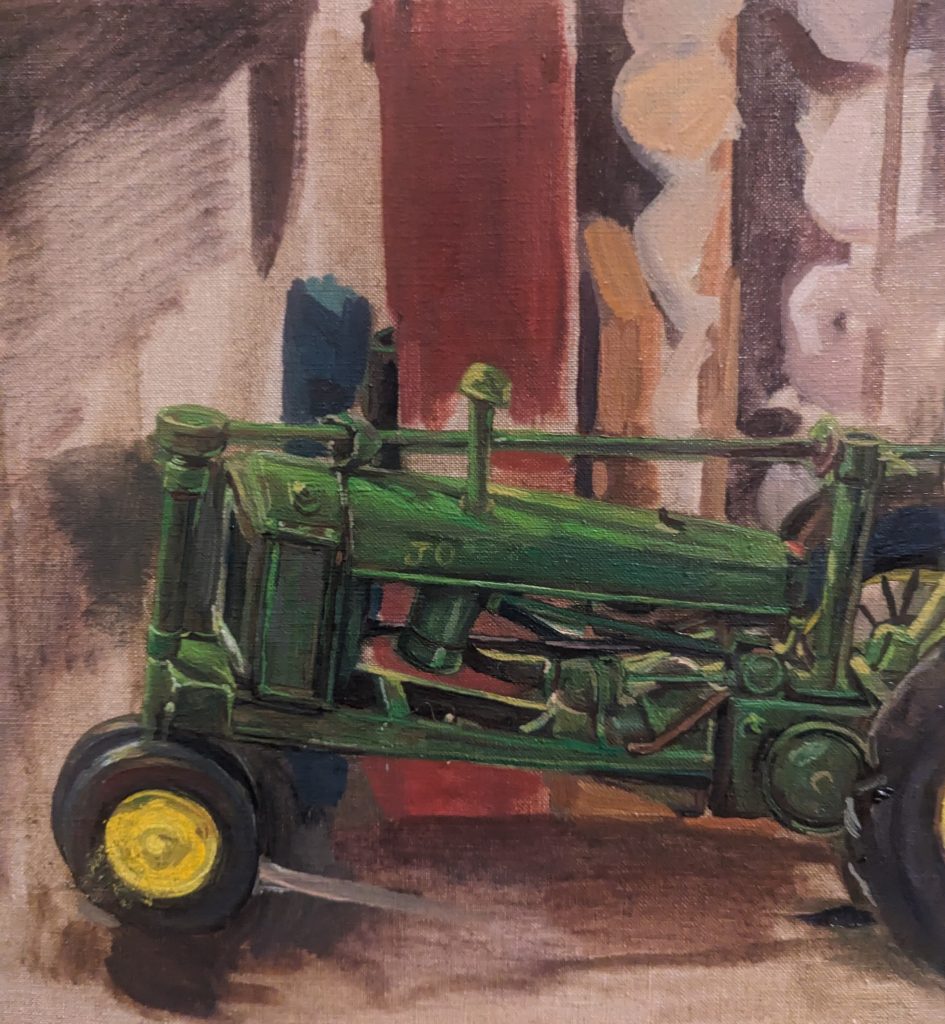
In the new global race war for minerals and sustainability, Hydrothermal Vents, existing 4,000 metres (13,000 feet) below the ocean surface, have become a source of exploitation and vulnerability.
Deep in the abyss, there is an oasis of life.
Rising from the seafloor in spire-like forms, 55 meter (180ft) high chimneys filled with hot mineral-rich fluids erupt, appearing as cities or fortresses. They are alien-like structures, existing at the furthest depths of the ocean. Despite extreme pressures, temperatures, and toxic chemicals, they support an abundance of lifeforms, many species of which are unique and cannot be found anywhere else on the planet.
I wanted to capture the otherworldly beauty and nature of these vents in my oil pastel drawings, as I was concerned about the need to protect and conserve them. The more I discover these vents, the more I realise how fundamental they are to the health of the planet and their role in the global energy crisis. Many vents are rich in rare earth metals like cobalt, gold, and copper, necessary ingredients for electronic components. Ed Conway, Economics and Data Editor at Sky News, has called our times an ‘arms race’ for battery production.
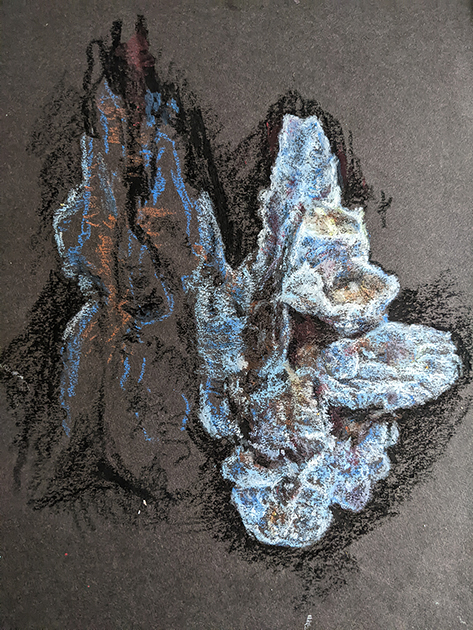
Since completing a short course on Oceanography, hosted by the University of Southampton, I have immersed myself in the ethereal and fascinating world of hydrothermal vents.
As part of the course, Dr. Jon Copley shared his experience of diving down in a submersible vehicle to the Cayman Ridge. I was immediately captivated by their enigmatic qualities, these strange, gnarly smoking spires erupting out of the earth’s crust. They looked primeval, and indeed are ancient, connecting the earth’s unseen inner architecture and our visible landscape. Some vent fields are active for 10,000 years.
My drawings of Castle Vent and El Guapo were inspired by images from a 2013 Science in the News (SITN) lecture, ‘The Alien Worlds of Hydrothermal Vents,’ presented by Heather Olins. The artwork ‘The Cathedral’ is an imagined landscape, based on maps of deep-sea vent fields on the ocean floor and images from the NOAA website.
Only 20% of the ocean has been explored, with just 5% of the ocean floor mapped. Due to its inhospitable conditions, inaccessibility, and cost, more people have been to the moon than they have to the bottom of the ocean. Yet life exists. As Heather argues, they are alien worlds; as satellites have difficulty penetrating water, we have better images of Mars than the ocean floor.
According to the National Oceanic and Atmospheric Administration (NOAA), scientists first discovered hydrothermal vents in 1977, whilst exploring an oceanic spreading ridge located near the Galapagos Islands. They noticed several temperature spikes in their data and wondered how the deep-ocean temperature could quickly change from near freezing to 400 degrees Celsius (750 degrees Fahrenheit).
These chimneys are found across the ocean, usually forming in vast vent fields, along the Mid-Ocean Ridges, such as the Mid Atlantic Ridge and the East Pacific Rise, stretching along 3000km of the mid-ocean ridge. They are essentially underwater hot springs or geysers, forming around volcanic regions as plate tectonics spread apart. Ocean water enters the fissures and percolates through the earth’s crust, becoming geothermally heated by the magma in the upper crust. The water collects minerals within the crust, such as iron and manganese; when it contacts the almost freezing seawater and oxygen, the dissolved minerals crystalize, solidifying to form chimney-like vents and depositing metalliferous sediments, alongside releasing plumes of toxic chemicals. The tallest vent found, ‘Godzilla,’ was 16 stories high before it collapsed in the 1990s.
Research of the Endeavour Field and other mid-ocean ridges has led MBARI geologists and researchers to propose the theory of Hydrothermal Vent Field/Ridge Evolution:
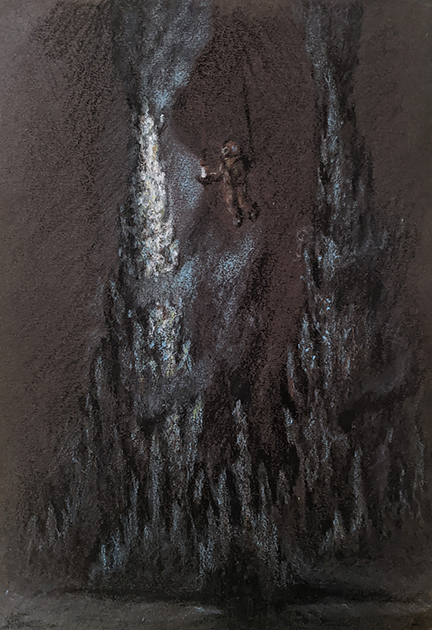
The scientists who discovered the vents were also shocked to discover hundreds of new species. The smokers supported unique ecosystems, composed of highly specialised and simple organisms, some thermophilic microbes that thrive in high temperatures, such as yeti crabs, giant tube worms, limpets, shrimp, and clams. These vent communities are ancient and well established, with many building blocks of life and some of the most primitive lifeforms on earth.
It confounded the science community. Before their discovery, it had been thought that life could only exist via photosynthesis and sunlight. Life at the bottom of the ocean would be scarce, the only energy available from scraps of whale carcasses.
The toxic concoction of chemicals present at these vents is lethal to most forms of life. However, despite the lack of sunlight, toxic minerals, chemicals, and extreme pressures and temperatures, bacteria were converting the poisonous vent minerals into energy through chemosynthesis, providing food for other vent organisms. Species’ existence may be cut short, as vents sometimes suddenly become inactive.
A few facts on Hydrothermal vent organisms:
Some vents emit carbon dioxide gas in a constant stream of bubbles.
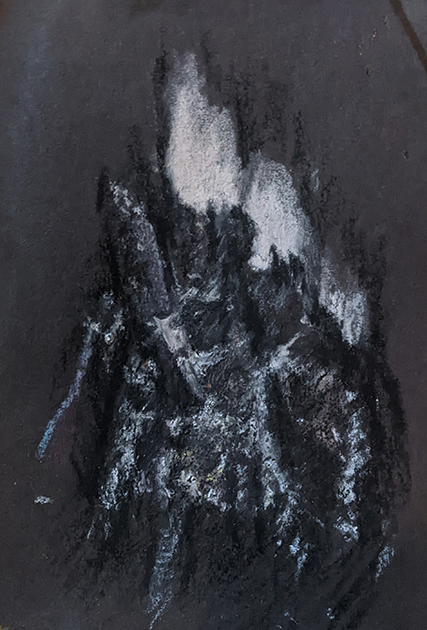
Vent zones contain polymetallic sulfides that are rich in zinc and copper. Large amounts of copper are deposited when the hydrothermal vents form. Inside the chimneys are seafloor massive sulfides (SMS) or sulfide deposits containing gold, cobalt, silver, and manganese.
In a hydrothermal vent cross-section shown in Heather’s lecture, minerals include white anhydrite sulfite, pyrite cubes ‘fool’s gold’ sulphide, iron, sulphur, zinc, mini crystals sphalerite, or chalcopyrite copper as opposed to zinc. The distinct layers are determined by temperature and chemistry. The more gold sulphide is found, the older and harder the vent is.
According to Woods Hole Oceanographic Institute, ‘seafloor deposits can be more than a thousand times richer in some metals than mineral deposits on land.’

Due to diminishing natural resources and fossil fuels in recent times and the transition to sustainability and renewable energy, mining companies have begun to consider the deep sea as the next mineral mine.
To achieve COP26’s 1.5C goal for climate change, the UK has entered a race war for precious minerals and metals, such as copper, cobalt, iron, gold, nickel, zinc, and aluminium, all of which are needed for a variety of industries, mainly as electronic components.
Alongside lithium, cobalt is a necessary ingredient necessary for battery production, however, its unsustainable and unethical means of obtaining it might inadvertently result in vent exploitation.
According to Goldman Sachs, demand for copper (used in electrical wiring) could rise 900% by 2030, its price predicted to reach $6.80 per pound by 2025. The metal has been hailed as ‘The new oil’ and even a national security issue due to its strategic value.
In an extract from Mining Feeds, the authors of the Goldman Sachs report ‘Nicholas Snowdon, Daniel Sharp, and Jeffrey Curries estimate that demand from electrification “will grow nearly 600% to 5.4Mt (million tonnes) in our base case and 900% to 8.7Mt in the case of hyper adoption of green technologies” by 2030. In the conservative base case, copper miners would see a massive demand to be filled surge faster than current production and production plans can accommodate. In the case of “hyper adoption of green technologies,” the world is likely to see a problematic copper shortage that is certain to push the price higher and faster.’
The University of Southampton’s oceanography course presenters, Professor Rachel Mills and Dr. Jon Copley revealed how companies have known about the mineral deposits at hydrothermal vents for years, however largely due to a lack of resources have been unable to obtain them. At deep-sea vents, there is a weight of a mile-and-a-half of ocean lying on top, ranging from 40 to over 110 times the pressure of Earth’s atmosphere.
Dr. Jon Copley began writing about the concerns of deep-sea mining and exploitation of copper in 2014: ‘Mining at deep-sea hydrothermal vents: what are potential impacts on marine life?’ A highly respected scientist who advised on the BBC’s Blue Planet series, Jon has been advising companies on how to do so sustainably, without damaging vent ecosystems.
It is incredibly important that marine geoscientists collaborate with companies and policymakers to ensure the ethical and sustainable extraction of resources if this becomes a necessity. The ocean is essential for life on this planet.
Hydrothermal vents act as a natural plumbing system, transporting heat and chemicals for the ocean, alongside adding elements from seafloor rocks. Scientists estimate that the entire volume of the world’s oceans cycles through hydrothermal vent systems along the global Mid-Ocean Ridge every 10-20 million years or so.
The ocean comprises approximately 70% of the planet we live on. You wouldn’t be wrong in saying we live on a Blue Planet.
The ocean is an incredible feat of nature:
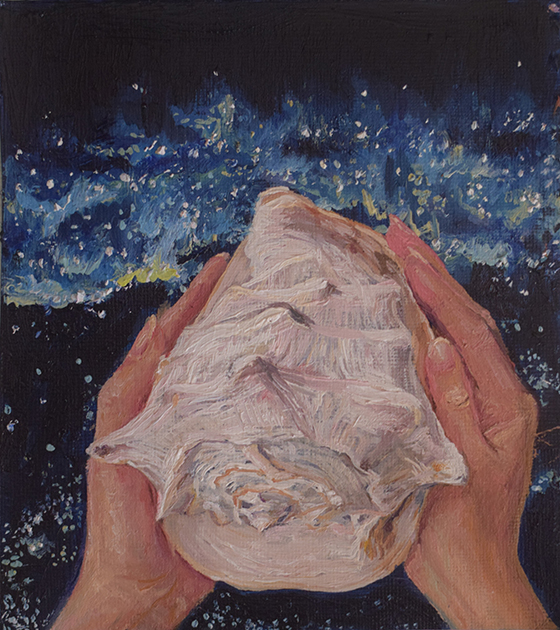
Astronauts like to visit the deep sea. Aside from mimicking zero gravity, it is like another planet.
Unique lifeforms can be found at hydrothermal vents that exist nowhere else. Known as extremophiles, these organisms thrive in hostile conditions that otherwise would be impossible. Active hydrothermal vents are believed to exist on Jupiter’s moon and natural satellite, Europa, and Saturn’s moon Enceladus. It is also believed that Mars might have once supported ancient hydrothermal vents.
Ganymede (another of Jupiter’s satellites) and Saturn’s satellite Titan are both thought to support life.
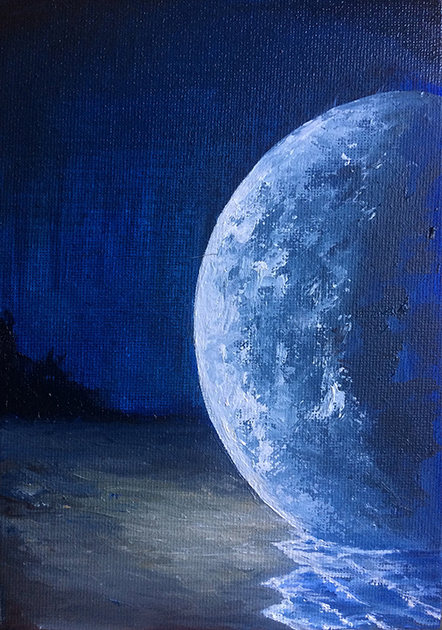
As the ocean is essential for life on this planet, so too are hydrothermal vents, being essentially connected to the ocean as a plumbing system. Their destruction could be disastrous.
The deep-sea is one of the last remaining mysteries of our planet to science. It is largely unexplored. However, this presents a dilemma: if we explore the last frontier on earth and discover all its secrets, species, and potential opportunities to help advance medicine or produce renewable energy, the ocean, and its incredible habitat become vulnerable to exploitation, deep-sea mining, and pollution. In our fervent, and perhaps reactionary desire to save the planet, our actions would be misled, no matter their pure intentions. In reaching for sustainability, it is compromising the very planet we are hoping to save.
There is a need for balance, to only take what we need from the planet, a circular economy. These vents may be subject to mining at some point, but it would need to be done sustainably or as a last resort. Ideally, we should consider other, more renewable alternatives and greener technologies.
It is imperative that the ocean is protected and that mining companies effectively collaborate with scientists around the world. Any exploration or exploitation should be done cautiously and with respect to ocean communities both in the sea and that rely on the sea.
It is a complex issue, and the solution is not always so clear-cut. I have always found the following quote inspiring and very poignant, in relation to maintaining the fine balance and health of the planet, and our relationship with it. Everything is connected. It is not random we are on this planet; we are custodians and guardians of the earth around us.
Sometimes it is indigenous peoples, and those with the closest connection to nature and their environment, that direction and wisdom can be found.
“Only when the last tree has been cut down, the last fish been caught, and the last stream poisoned, will we realize we cannot eat money.”
Cree First Nations proverb.
During the summer of 2020, I thought it would be fun to explore my interest in the natural history of our planet and its many mysteries, by enrolling in a few (three, to be exact) online courses. I have been interested in myths and legends like sea monsters and their symbolism in different cultures for a long time, as well as the scientific knowledge behind them.
After researching a few courses online, I signed up for Dino 101: Dinosaur Paleobiology and Paleontology: Ancient Marine Reptiles at The University of Alberta, Canada, which is currently running a number of Massive Open Online Courses (MOOCS).
Since their extinction, the fossilized remains of giant dinosaurs and ancient marine reptiles have taken on an almost mythical status and have understandably inspired generations.
I find it interesting how people interpret any new species using their imagination and pre-held associations; I am reminded of a woodcut that Albrecht Dürer produced based on someone’s description of an armoured rhinoceros:
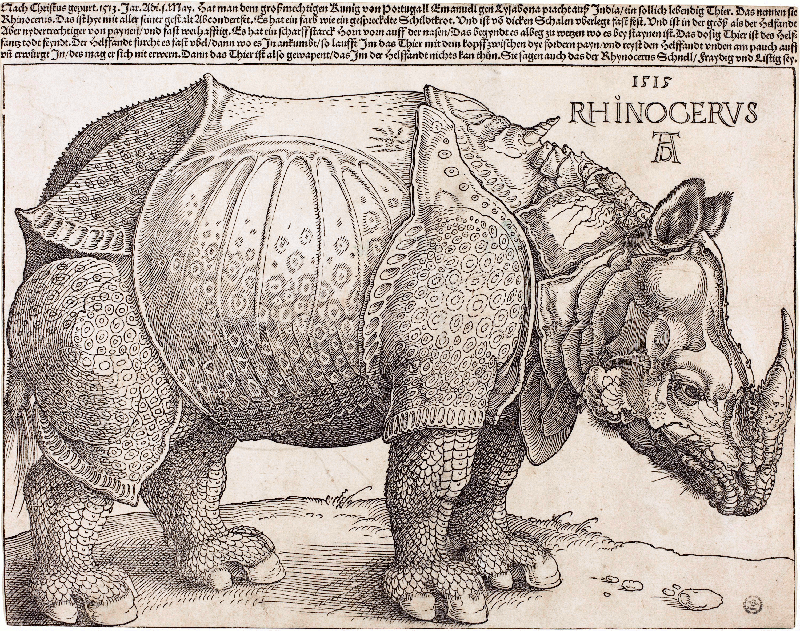
I found the University of Alberta’s courses were fascinating and well presented, with generous resources to present paleobiology in a dynamic new way. They were great foundations to practice and learn scientific critical thinking.
Here is a brief overview of the courses at the University of Alberta.
The world’s first paleobiology MOOC, Dino 101 is led by Dr. Phil Currie, Curator of Dinosaurs and Professor of Paleobiology at the University of Alberta, alongside former MSc student of Paleontology, Betsy Kruk. The course consists of twelve lessons covering the Mesozoic era (Triassic, Jurassic, and Cretaceous periods). Learn more about non-avian dinosaurs such as Stegosaurus, Spinosaurus, long-necked sauropods like Brachiosaurus, and predatory Therapods like Allosaurus, Velociraptors, and Tyrannosaurus Rex. Lessons are delivered from museums, fossil-preparation labs, and dig sites, highlighting the rich resources of Alberta. To aid their learning, students can build a skeleton during the course, and use a fossil viewer.
Topics include:
This is a four-lesson MOOC presented by Dr. Scott Persons, a former Ph.D. student of Evolution and Systematics at the University of Alberta. The course assesses the diversity, adaptations, convergence, and phylogenetic relationships of extinct marine reptiles, and the changes that occur when air-breathing terrestrial animals return to the water. The course makes many comparisons to extant (living) reptiles and animals, giving students a comprehensive introduction to animal biology.
Fun fact: Ancient marine reptiles are NOT dinosaurs!
The course focused on the following extinct marine reptiles and how they solved the aquatic problem such as movement, sight, and hearing:
Thank you to the scientists who took the time to deliver the courses in such a fun and engaging way.
Thank you also to Dr. Phil Currie for suggesting I draw the pictured dinosaur skull of their most famous specimen, a small pachycephalosaurid named Stegoceras that was first discovered in Alberta. Its domed skull, horns, and teeth have been remarkably well preserved, I enjoyed capturing the various textures in pencil:
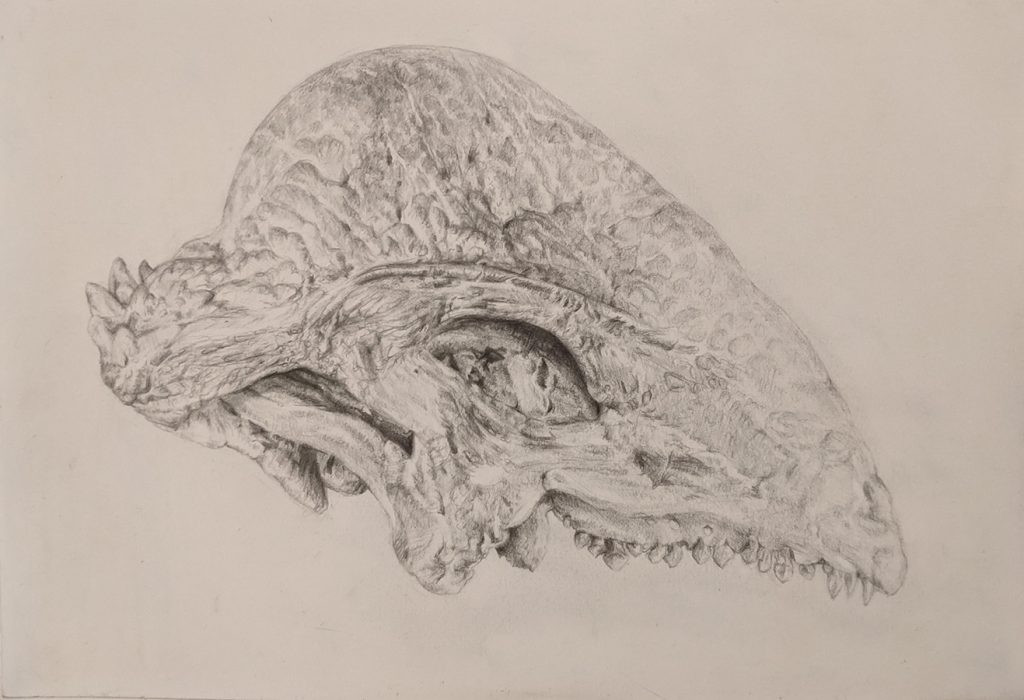
Goodwood Revival is a unique three-day festival held annually in September that recreates the 1940s, 50s, and 60s era of motorsport, with vintage cars, aircraft, fashion, and music celebrating the circuit’s original period between 1948-1966. Held on the grounds of the Goodwood Estate in Chichester, West Sussex, UK, over 150,000 vintage enthusiasts are encouraged to dress in period clothes to help immerse themselves in a historic car race day.
My family and I had booked to attend the Goodwood Revival finals day on Sunday, 13th September 2020, however, due to efforts to fight the coronavirus pandemic, the event has sadly been postponed until 2021. The Revival attracts such large crowds of spectators that enforced social distancing measures would have impaired the visitor’s enjoyment of the event.
Despite being unable to hold the event this year, the Goodwood team has searched the archive and selected the greatest races from the history of the Revival to stream online over 11-13th September 2020. Fans can still immerse themselves in the spirit of Goodwood Revival by tuning in from 10:00 am on the Goodwood Road and Racing website and on Facebook, Twitter, and Instagram.
Goodwood is also taking the opportunity to preview Goodwood SpeedWeek presented by Mastercard. Held without spectators at Goodwood Motor Circuit, this inaugural event will combine the best aspects from the Revival, the Festival of Speed, and their Members’ Meetings to add to its exclusivity.
Annual Revival favourites such as the RAC TT Celebration for GT cars and the Grand Prix race for the Goodwood Trophy, as well as supercar debuts and new car reveals from the Festival of Speed. Cars will leave the circuit to use areas normally reserved for spectators or buildings. There will also be the first-ever set of rally stages on both tarmac and gravel within the Circuit, gathering cars that represent nearly half a century of the World Rally Championship.
The event will be streamed live through the Goodwood Road and Racing website and their social media channels on Facebook, Twitter, and Instagram. Viewers and fans will be able to get involved by participating in competitions, virtual polls, quizzes, and race predictions.
I had already decided to draw several classic cars, supercars, and motorbikes over a few months in the summer, due to a client’s interest in a commission. It also happened to be the birthday of a family member and taking the Revival as inspiration, I drew the 1958 Lister-Chevrolet ‘Knobbly’ in pencil as a gift.
There were many beautiful classic cars at Goodwood Revival, but I chose to draw the 1958 Lister-Chevrolet ‘Knobbly’ as its aerodynamic design, sleek, elongated curves, side exhaust pipes, and unique appearance immediately appealed to me. It was also one of the historic cars racing that day. This particular model caught my eye just before it was due to race on the circuit. I changed the racing number to a 7 as I knew it was the favourite number of the person for whom I gifted the drawing. I thought that a pencil drawing would give a handcrafted and classic, vintage look, as opposed to an oil painting in colour.

I am naturally inclined towards vintage and classic cars, possibly because I have been raised in a family that has enjoyed, collected, and driven classic cars over the years. However, as a fine artist, I think that classic car designs have a sophisticated degree of individuality and are incredibly beautiful; their handcrafted look appears as a work of art. I will admit that classic cars are not necessarily the most practical, but they are beautiful to look at and the feeling you get when driving or being driven in one adds far more to the driving experience.

Founded by Brian Lister in 1951, Lister Motor Company is Britain’s oldest car racing manufacturer and was the country’s most successful sports racing car of the 1950s; it won almost every circuit in the UK and was virtually unbeaten overseas. It is now perhaps the most respected historic race car manufacturer in the world.
Lister Classics is a division of the Lister Motor Company and was founded by Father and son team, Andrew and Lawrence Whittaker, who purchased the company in 2013 to continue building, restoring, and selling a variety of historic racing cars and tuned Jaguar vehicles. You can follow Lister’s official social media accounts on Facebook, Instagram, and Twitter.
As a gloriously fun step back in time, Goodwood Revival celebrates not only the cars of the 40s-60s eras but also the fashion styles. For anyone who loves vintage fashion, Goodwood Revival is a wonderful event to immerse yourself in.
The Goodwood Revival website has various site pages dedicated to vintage fashion, with ladies and gentlemen style guides for the 1940s, ’50s, and ’60s. There are also a few websites that provide style guides for Goodwood Revival specifically, such as the House of Foxy which gives advice on the ’40s and ’50s clothes for women.

To find out more about attending the Goodwood Revival and Festival of Speed events in 2021, visit Goodwood’s website to sign up for ticket alerts.
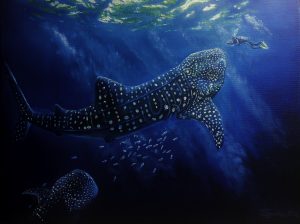
Most sharks prefer temperate climates, except for Greenland sharks, which live in the Arctic and Northern Atlantic. Some whale sharks have been found in colder North Atlantic water near New York, but most are found in warm, tropical waters such as the Indian and Pacific Oceans.
According to this National Geographic video, titled ‘Investigating the Mysterious Whale Sharks of Mafia Island,’ whale sharks help support small ecosystems, as they are often found with schools of smaller fish alongside them, presumably hoping to catch small morsels or plankton when the shark feeds.
My painting shows a school of smaller fish following one of the whale sharks:
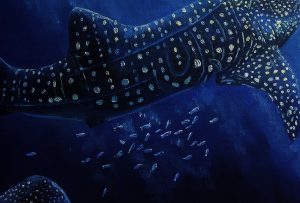
Interestingly, this phenomenon has inspired local fishermen living on Mafia Island, Tanzania, to work alongside whale sharks to catch the fish without harming the sharks.
Although often found at the surface, whale sharks can dive further than 1000 metres. In one study, based in the Saudi Arabian Red Sea, researchers used three types of satellite-transmitting tags to track the movements of 47 whale sharks.
Their findings were impressive:
The whale shark is usually solitary, however, it is sometimes found in schools of up to hundreds of individuals. These animals are found mainly in the open sea, but they sometimes come near the shore. Their age of sexual maturity and reproductive biology is unconfirmed, however, scientists presume that whale sharks are ovoviviparous, where the females incubate fertilized eggs inside her before they hatch, giving birth to fully formed live young. You can read more about ovoviviparity, and how it differs to viviparity, here. Each litter contains about 16 young, but litters of many more are possible. In the mid-1990s a female whose uterus contained nearly 300 young was caught near Taiwan. Like the other mysteries surrounding whale sharks, they have never been observed giving birth, and it is not known where this may happen.
It is thought that whale sharks are born between 40-60cm, but there are few sightings of individuals below 3m, and no one has yet determined where they go before reaching this size. However, one whale shark measuring just 38cm was found in the Philippines in 2009, suggesting it was a birthing ground and not simply used for feeding.
The gigantic size of whale sharks suggests they can live up to 100 years.
Aside from its abundant natural mineral resources including gold and nickel (the country has the second largest gold deposit in the world), the Philippines is a biodiversity hotspot and a popular place for whale sharks to congregate; it is an archipelago consisting of more than 7,000 islands and is the smallest of the 17 megadiverse countries in the world. The Philippines covers only 2/100 of the total land area of the earth, yet 20,000 species of plants and animals have been recorded here, half of which are found nowhere else in the world. Read more on its biodiversity here.
Donsol, in the Philippine province of Sorsogon, has been identified as a whale shark hotspot, hosting one of the largest aggregations of whale sharks on Earth. 491 individual whale sharks have been identified at Donsol, this equates to 44% of all whale sharks identified in the country. Other large aggregations include Ningaloo Reef in Australia, Mexico, and Mozambique.
15 years ago, WWF Philippines partnered with Donsol and other tourism stakeholders to develop the Community-based Whale Shark Ecotourism Program and establish guidelines for whale shark interactions. Scientists are responsible for researching and studying individual sharks in an attempt to conserve them.
There are over 440 species of sharks in the world. These awesome creatures have outlived the dinosaurs, but many are now sadly threatened with extinction.
Indeed, whale sharks have no natural predators apart from people.
We need to remember that the ocean is their territory, not ours. Predatory species such as the great white, bull shark, or tiger shark, only attack if they confuse a person for their prey, usually fish or seals. It is best to bear this in mind if we choose to swim in areas of the ocean where they are present.
All marine life is essential to a healthy ecosystem and that of the planet as a whole. Sharks are vital as they maintain the species below them and are indicators of ocean health. The apex predators feed on weak and sick animals and ensure biodiversity.
Coral reef ecosystems, seagrass beds, and commercial fisheries have all declined due to the loss of sharks. Without sharks, larger predatory fish, such as groupers, increase in abundance in the coral reefs and feed on the herbivores. As the herbivores decrease, macroalgae increase and expand, leading to the loss of coral and the detriment of the entire reef system.
I recently completed a four-week online course with the University of Southampton on ‘Exploring Our Ocean.’ One of the tasks was to upload an image, title, and description, to represent what the ocean meant to me; I uploaded my painting of whale sharks and titled it, ‘Majestic and Awe-Inspiring, yet Vulnerable.’ The wonders of nature surround us. For it to continue to inspire us, we should try to protect it from threats and exploitation.
Shark Week